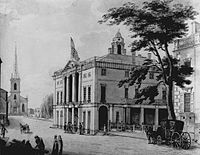20th New York State Legislature
| 20th New York State Legislature | |||||
|---|---|---|---|---|---|
|
|||||

The Old New York City Hall, where the Legislature first met in 1784. From January 1785 to August 1790, the Congress of the Confederation and the 1st United States Congress met here, and the building was renamed Federal Hall. From 1791 to 1793, and from 1795 to 1796, the State Legislature met again here. The building was demolished in 1812. (1798)
|
|||||
| Overview | |||||
| Jurisdiction | New York, United States | ||||
| Term | July 1, 1796 – June 30, 1797 | ||||
| Senate | |||||
| Members | 43 | ||||
| President | Lt. Gov. Stephen Van Rensselaer (Fed.) | ||||
| Party control | Federalist (36-6) | ||||
| Assembly | |||||
| Members | 108 | ||||
| Speaker | Gulian Verplanck (Fed.) | ||||
| Party control | Federalist | ||||
| Sessions | |||||
|
|||||
| 1st | November 1 – 11, 1796 |
|---|---|
| 2nd | January 3 – April 3, 1797 |
The 20th New York State Legislature, consisting of the New York State Senate and the New York State Assembly, met from November 1, 1796, to April 3, 1797, during the second year of John Jay's governorship, first in New York City, then in Albany.
Under the provisions of the New York Constitution of 1777, the State Senators were elected on general tickets in the senatorial districts, and were then divided into four classes. Six senators each drew lots for a term of 1, 2, 3 or 4 years and, beginning at the election in April 1778, every year six Senate seats came up for election to a four-year term. Assemblymen were elected countywide on general tickets to a one-year term, the whole assembly being renewed annually.
In March 1786, the Legislature enacted that future Legislatures meet on the first Tuesday of January of each year unless called earlier by the governor. No general meeting place was determined, leaving it to each Legislature to name the place where to reconvene, and if no place could be agreed upon, the Legislature should meet again where it adjourned.
On July 1, 1795, Stephen Van Rensselaer took office as Lieutenant Governor of New York, leaving a vacancy in the Western District.
On March 4, 1796, the Legislature re-apportioned the Senate and Assembly districts, based on the figures of the New York State Census of 1795. The number of State Senators was increased from 24 to 43, adding 1 to the Southern D.; and 6 each to the other three districts. The number of assemblymen was increased from 70 to 108, double-county districts were separated, and several new counties were created.
At this time the politicians were divided into two opposing political parties: the Federalists and the Democratic-Republicans.
The State election was held from April 26 to 28, 1796. Senator Selah Strong (Southern D.) was re-elected. Assemblymen James Watson (Southern D.), Thomas Morris, Johannes Dietz, Jacob Morris, Leonard Bronck and Francis Nicoll (all five Western D.) were elected to the Senate. Samuel Haight, Andrew Onderdonk (both Southern D.), Robert Sands, Christopher Tappen, William Thompson (all three Middle D.), Ebenezer Clark, Moses Vail, James Savage, Peter Silvester, Anthony Ten Eyck (all five Eastern D.), Jedediah Sanger, James Gordon, Leonard Gansevoort, Thomas R. Gold, John Richardson, Vincent Mathews, Joseph White and Abraham Arndt (all eight Western D.) were also elected to the Senate. All, except Christopher Tappen, were Federalists.
...
Wikipedia
